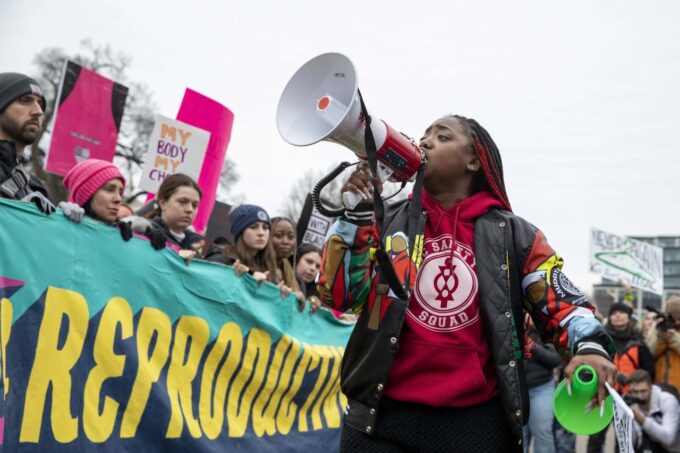Black woman charged after miscarriage shows post-Roe the perils
COLUMBUS, Ohio (AP) — Ohio was in the throes of a bitter debate over abortion rights this fall when Brittany Watts, 21 weeks and 5 days pregnant, began passing thick blood clots.
The 33-year-old Watts, who had not shared the news of her pregnancy even with her family, made her first prenatal visit to a doctor’s office behind Mercy Health-St. Joseph’s Hospital in Warren, a working-class city about 60 miles (100 kilometers) southeast of Cleveland.
The doctor said that, while a fetal heartbeat was still present, Watts’ water had broken prematurely and the fetus she was carrying would not survive. He advised heading to the hospital to have her labor induced, so she could have what amounted to an abortion to deliver the nonviable fetus. Otherwise, she would face “significant risk” of death, according to records of her case.
That was a Tuesday in September. What followed was a harrowing three days entailing: multiple trips to the hospital; Watts miscarrying into, and then flushing and plunging, a toilet at her home; a police investigation of those actions; and Watts, who is Black, being charged with abuse of a corpse. That’s a fifth-degree felony punishable by up to a year in prison and a $2,500 fine.
Her case was sent last month to a grand jury. It has touched off a national firestorm over the treatment of pregnant women, and especially Black women, in the aftermath of the U.S. Supreme Court’s Dobbs v. Jackson Women’s Health Organization decision that overturned Roe v. Wade. Civil rights attorney Benjamin Crump elevated Watts’ plight in a post to X, formerly Twitter, and supporters have donated more than $100,000 through GoFundMe for her legal defense, medical bills and trauma counseling.
Whether abortion-seekers should face criminal charges is a matter of debate within the anti-abortion community, but, post-Dobbs, pregnant women like Watts, who was not even trying to get an abortion, have increasingly found themselves charged with “crimes against their own pregnancies,” said Grace Howard, assistant justice studies professor at San José State University.
“Roe was a clear legal roadblock to charging felonies for unintentionally harming pregnancies, when women were legally allowed to end their pregnancies through abortion,” she said. “Now that Roe is gone, that roadblock is entirely gone.”
Michele Goodwin, a law professor at the University of California, Irvine, and author of “Policing The Womb,” said those efforts have long overwhelmingly targeted Black and brown women.
Even before Roe was overturned, studies show that Black women who visited hospitals for prenatal care were 10 times more likely than white women to have child protective services and law enforcement called on them, even when their cases were similar, she said.
“Post-Dobbs, what we see is kind of a wild, wild West,” said Goodwin. “You see this kind of muscle-flexing by district attorneys and prosecutors wanting to show that they are going to be vigilant, they’re going to take down women who violate the ethos coming out of the state’s legislature.” She called Black women “canaries in the coal mine” for the “hyper-vigilant type of policing” women of all races might expect from the nation’s network of health-care providers, law enforcers and courts now that abortion isn’t federally protected.
News
In Texas, for example, Republican Attorney General Ken Paxton mounted an aggressive and successful defense against a white Texas mother, Kate Cox, who sued for permission to skirt the state’s restrictive abortion law because her fetus had a fatal condition.
At the time of Watts’ miscarriage, abortion was legal in Ohio through 21 weeks, six days of pregnancy. Her lawyer, Traci Timko, said Watts left the hospital on the Wednesday when, coincidentally, her pregnancy arrived at that date — after sitting for eight hours awaiting care.
It turned out the delay was because hospital officials were deliberating over the legalities, Timko said. “It was the fear of, is this going to constitute an abortion and are we able to do that,” she said.
At the time, vigorous campaigning was taking place across Ohio over Issue 1, a proposed amendment to enshrine a right to abortion in Ohio’s constitution. Some of the ads were harshly attacking abortions later in pregnancy, with opponents arguing the issue would allow the return of so-called “partial-birth abortions” and pregnancy terminations “until birth.”
The hospital did not return calls seeking confirmation and comment, but B. Jessie Hill, a law professor at Case Western Reserve University School of Law in Cleveland, said Mercy Health-St. Joseph’s was in a bind.
“These are the razor’s edge decisions that health care providers are being forced to make,” she said. “And all the incentives are pushing hospitals to be conservative, because on the other side of this is criminal liability. That’s the impact of Dobbs.”
Watts had been admitted to the Catholic hospital twice that week with vaginal bleeding, but she left without being treated. A nurse told the 911 dispatcher that Watts returned no longer pregnant on that Friday. She said Watts told her, “the baby’s in her backyard in a bucket,” and that she didn’t want to have a child.
Timko said Watts insists she doesn’t recall saying the pregnancy was unwanted; it was unintended, but she had always wanted to give her mother a grandchild. Her lawyer believes Watts may have meant that she didn’t want to fish what she knew was a dead fetus from the bucket of blood, tissue and feces that she’d scooped from her overflowing toilet.
“This 33-year-old girl with no criminal record is demonized for something that goes on every day,” she told Warren Municipal Court Judge Terry Ivanchak during Watts’ recent preliminary hearing.

Warren Assistant Prosecutor Lewis Guarnieri told Ivanchak that Watts left home for a hair appointment after miscarrying, leaving the toilet clogged. Police would later find the fetus wedged in the pipes.
“The issue isn’t how the child died, when the child died,” Guarnieri told the judge, according to TV station WKBN. “It’s the fact the baby was put into a toilet, was large enough to clog up the toilet, left in that toilet, and she went on (with) her day.”
In court, Timko bristled at Guarnieri’s suggestion.
“You cannot be broadcasting any clearer that you just don’t get it,” she said in an interview, suggesting Watts was scared, anxious and traumatized by the experience. “She’s trying to protect Mama. She doesn’t want to get her hair done. She wants to stop bleeding like crazy and start grieving her fetus, what she’s just been through.”
As chief counsel to the county’s child assault protection unit, Assistant Trumbull County Prosecutor Diane Barber is the lead prosecutor on Watts’ case.
Barber said she couldn’t speak specifically about the case other than to note that the county was compelled to move forward with it once it was bound over from municipal court. She said she doesn’t expect a grand jury finding this month.
“About 20% of the cases get no-billed, (as in) they do not get indicted and the case does not proceed,” she said.
The size and stage of development of Watts’ fetus — precisely the point when abortion crossed from legal to illegal in most cases — became an issue during her preliminary hearing.
A county forensic investigator reported feeling “what appeared to be a small foot with toes” inside Watts’ toilet. Police seized the toilet and broke it apart to retrieve the intact fetus as evidence.
Testimony and an autopsy confirmed that the fetus died in utero before passing through the birth canal. In regard to abuse, the examination identified “no recent injuries.”
Ivanchak acknowledged the case’s complexities.
“There are better scholars than I am to determine the exact legal status of this fetus, corpse, body, birthing tissue, whatever it is,” he said from the bench. “Matter of fact, I’m assuming that’s what … Issue 1’s all about: at what point something becomes viable.”
Timko, a former prosecutor, said Ohio’s abuse-of-corpse statute is vague. It prohibits treating “a human corpse” in a way that would “outrage” reasonable family or community sensibilities.
“From a legal perspective, there’s no definition of ‘corpse,’” she said. “Can you be a corpse if you never took a breath?”
Howard said clarity on what about Watts’ behavior constituted a crime is essential.
“For rights of people with the capacity for pregnancy, this is huge,” she said. “Her miscarriage was entirely ordinary. So I just want to know what (the prosecutor) thinks she should have done. If we are going to require people to collect and bring used menstrual products to hospitals so that they can make sure it is indeed a miscarriage, it’s as ridiculous and invasive as it is cruel.”
Never miss a beat: Get our daily stories straight to your inbox with theGrio’s newsletter.
Source link
Ohio was debating abortion rights when Brittany Watts, who was 21 weeks and 5 days pregnant, was advised by a doctor to induce labor due to her fetus being nonviable. She miscarried three days later, flushed and plunged the toilet she used, which led to a police investigation and charges of abuse of a corpse. After Roe v. Wade was overturned, more pregnant women like Watts have faced charges for unintentionally harming pregnancies, disproportionately targeting Black and brown women. Watts case has garnered national attention and a civil rights attorney has amplified her story on social media, leading to support through a GoFundMe page. The legal status of her fetus prevailed in her case, complicating the charges against her. The case, which has raised questions about the treatment of pregnant women, especially Black women, continues to unfold in the aftermath of the U.S. Supreme Court’s decision. The treatment of Watts has raised further concerns about the criminalization of pregnant women, how hospitals decide on necessary care, and the impact of the Dobbs decision on the policing of pregnancies.



